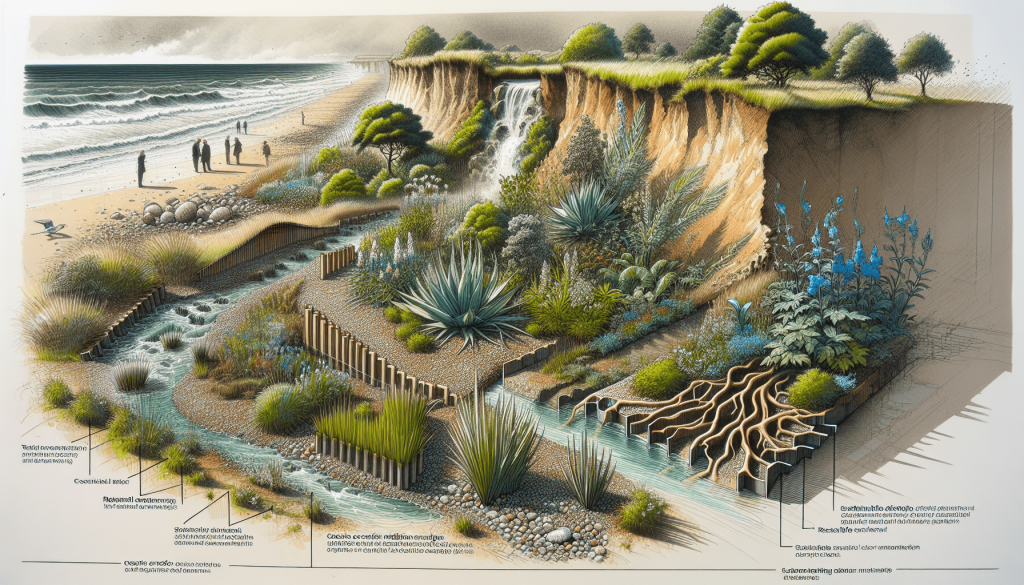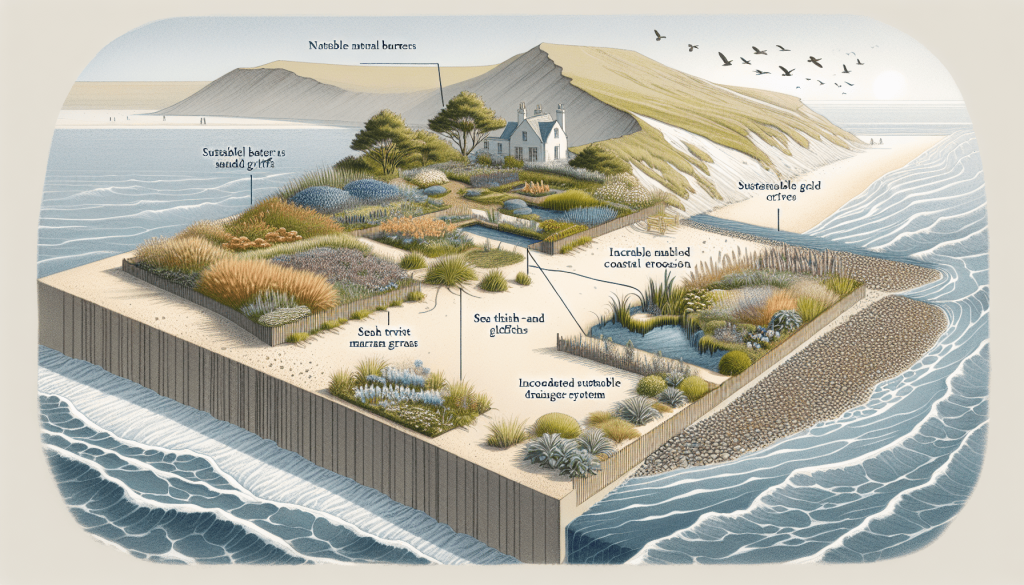Imagine you are living beside a beautiful coastal area in the UK, but facing the constant threat of coastal erosion. You want to design a garden that not only looks stunning but also provides a solution to this problem. In this article, we will explore some creative ideas and strategies for designing a garden that not only withstands the effects of coastal erosion but also adds to the beauty and charm of your coastal home. So, let’s dive in and discover how you can create a garden that is both breathtaking and environmentally friendly in the face of coastal erosion.
Table of Contents
ToggleUnderstanding Coastal Erosion
Coastal erosion refers to the wearing away of land and the removal of sediment along coastlines. It is a natural process influenced by a variety of factors such as wave action, tidal forces, and weather patterns. Understanding the causes and impacts of coastal erosion is crucial in designing effective solutions to mitigate its effects.
Causes of Coastal Erosion
Coastal erosion can be caused by various natural and human-induced factors. Natural causes include wave action, storms, sea level rise, and longshore drift. These forces can gradually erode the coastline, leading to the loss of beach sand and land. Human activities such as coastal development, dredging, and the construction of hard structures like seawalls can also contribute to accelerated erosion.
Impacts of Coastal Erosion
Coastal erosion can have significant impacts on both the natural environment and human communities. It can result in the loss of valuable land, including residential and commercial properties. Erosion can also lead to the destruction of infrastructure such as roads, railways, and utilities. Moreover, the loss of coastal habitats can affect biodiversity, disrupt ecosystems, and impact the livelihoods of local communities that rely on coastal resources.
Coastal Erosion in the UK
Coastal erosion is a pressing issue in the UK, where approximately 17% of the coastline is eroding at an average rate of 2 meters per year. The country faces unique challenges due to its island geography and susceptibility to rising sea levels. The vulnerable areas include iconic coastal towns, natural heritage sites, and important ecological habitats. Understanding the specific erosion patterns and risks in different regions is crucial for developing tailored solutions.
Planning for Coastal Erosion Solution
When designing a garden with a coastal erosion solution, thorough planning and careful consideration of various factors are essential. This section outlines key steps involved in the planning process.
Site Analysis
Conducting a comprehensive site analysis is the first step in planning for a coastal erosion solution. This involves assessing the current state of the site, including the extent of erosion, soil conditions, and existing vegetation. Understanding the unique characteristics of the site will help determine the appropriate erosion control measures and garden design.
Consulting Experts
Engaging with experts such as landscape architects, coastal engineers, and ecologists is crucial in developing an effective erosion control plan. These professionals possess the knowledge and experience to assess the site’s vulnerabilities, identify suitable erosion control measures, and provide guidance on garden design that integrates with the coastal landscape.
Legal Considerations
Before implementing any erosion control measures, it is important to consider local regulations and obtain any necessary permits or approvals. Coastal development often involves legal considerations, including setback requirements, protected species habitats, and environmental regulations. Adhering to these requirements ensures compliance with the law and helps protect the coastal environment.
Designing a Garden with Coastal Erosion Solution
Designing a garden that incorporates a coastal erosion solution requires careful consideration to create a balance between aesthetic appeal and functionality. The following are key elements to consider when designing such a garden.
Incorporating Coastal Plants
Choosing native coastal plants that are adapted to the harsh coastal environment can be instrumental in stabilizing the soil and preventing erosion. These plants typically have deep root systems that help anchor the soil and provide natural protection against wave action and wind. Additionally, they provide habitat for local wildlife and contribute to the overall beauty of the garden.
Creating Slopes and Terraces
Designing slopes and terraces can help manage and redirect water flow, reducing the risk of erosion. Gradual slopes with strategically placed plants or ground covers can help slow down water runoff and promote infiltration, minimizing erosion. Terracing the garden can also enhance its visual appeal while providing effective erosion control.
Using Retaining Walls
Retaining walls can serve as an effective erosion control measure when designed and installed correctly. They help stabilize slopes, prevent soil erosion, and create distinct levels within the garden. However, it is crucial to choose appropriate materials and construct the walls according to engineering specifications to ensure their effectiveness and structural integrity.
Implementing Erosion Control Measures
Once the garden design has been finalized, it is essential to implement erosion control measures correctly. This section explores key aspects of the implementation process.
Choosing the Right Materials
Selecting high-quality and durable materials is crucial for the longevity and effectiveness of erosion control measures. This includes choosing erosion-resistant plants, erosion control fabrics, and suitable construction materials for retaining walls or other structural elements. Using materials that are compatible with the local environment will ensure the success of erosion control efforts.
Construction Process
The construction process should be carried out according to approved plans and specifications. This may involve excavating and grading the site, installing retaining walls or erosion control fabrics, and planting native vegetation. Adhering to best practices during construction will help promote the stability and resilience of the garden in the face of coastal erosion.
Maintenance and Monitoring
Regular maintenance and monitoring are essential to ensure the long-term success of erosion control measures. This includes watering and fertilizing plants, removing invasive species, and inspecting retaining walls for signs of damage or instability. Monitoring erosion patterns and adjusting the garden design as needed will help address any emerging issues before they become severe.
Blending Aesthetics with Functionality
Designing a garden with a coastal erosion solution involves finding a balance between aesthetic appeal and practicality. Consider the following factors to achieve this balance.
Choosing the Right Garden Features
Selecting garden features that complement the coastal environment can enhance the overall aesthetic appeal of the design. This may include incorporating elements such as driftwood sculptures, sea-inspired artwork, or beach-themed decorative items. Integrating these features seamlessly into the garden can create a visually stunning space that reflects the coastal landscape.
Integrating Nature-Based Solutions
Nature-based solutions, such as using natural materials, incorporating organic shapes, and promoting biodiversity, can enhance the functionality and ecological resilience of the garden. Utilizing native plants, creating habitat structures for wildlife, and designing rainwater collection systems are examples of nature-based solutions that blend seamlessly with the coastal environment.
Considering Access and Safety
In addition to aesthetics, it is crucial to consider accessibility and safety when designing a garden with a coastal erosion solution. This may involve incorporating wheelchair-friendly paths, installing handrails on slopes, and using non-slip materials in areas prone to erosion. Ensuring safe and easy access for garden visitors will enhance their enjoyment and reduce potential hazards.
Preserving Natural Habitat
Designing a garden with a coastal erosion solution provides an opportunity to contribute to the preservation of natural habitats. Consider the following strategies to promote the preservation of coastal vegetation and wildlife.
Protecting Coastal Vegetation
Designing the garden in a way that protects and preserves existing coastal vegetation is crucial for maintaining the ecological balance. Avoiding unnecessary removal of plants, implementing proper pruning techniques, and avoiding the use of harmful chemicals will help safeguard the coastal vegetation.
Promoting Biodiversity
Integrating a wide variety of native plant species in the garden can promote biodiversity and attract different wildlife species. Selecting plants that provide food and shelter for birds, insects, and other animals will contribute to the overall ecological health of the area. Incorporating features like bird feeders, nesting boxes, and water sources can further enhance biodiversity.
Nurturing Wildlife Habitats
Creating dedicated spaces within the garden for wildlife, such as bird feeding stations, butterfly gardens, or small ponds, can provide essential habitats for different species. These habitats can support breeding, nesting, and foraging activities, ensuring the long-term survival of local wildlife populations.
Managing Rainwater Runoff
Proper management of rainwater runoff is essential in preventing erosion and maintaining the health of the garden. Consider the following strategies to effectively manage rainwater.
Creating Rain Gardens
Rain gardens are designed to capture and absorb rainwater, reducing the volume and velocity of runoff. They typically feature plants with deep root systems that can absorb excess water and filter out pollutants. Incorporating a rain garden within the coastal erosion solution can help manage stormwater runoff and prevent erosion while enhancing the overall beauty of the garden.
Installing Permeable Surfaces
Using permeable surfaces, such as permeable paving or gravel, allows rainwater to infiltrate the soil instead of running off the surface. This helps prevent erosion by reducing the amount of water flowing over the garden. Furthermore, permeable surfaces promote groundwater recharge and reduce the burden on stormwater drainage systems.
Implementing Drainage Systems
Installing an effective drainage system is crucial for managing excess water and preventing erosion. This may include stormwater drains, French drains, or underground pipes that redirect water away from vulnerable areas. Properly designed drainage systems can help prevent water accumulation and erosion, ensuring the longevity of the garden.
Accounting for Sea Level Rise
With the increasing threat of sea level rise, it is imperative to consider adaptation measures and future-proof the garden design. Consider the following strategies to account for sea level rise.
Future-Proofing Design
Designing the garden with long-term resilience in mind is key to adapting to rising sea levels. This may involve raising the garden’s elevation, integrating flood-resistant materials, and utilizing floating gardens or raised beds. By considering potential sea level rise scenarios, the garden can be designed to withstand and adapt to future changes.
Considering Adaptation Measures
Implementing adaptive measures can help mitigate the impacts of sea level rise and improve the garden’s resilience. This may include using salt-tolerant plants, creating buffers or berms to absorb wave energy, and implementing shoreline stabilization measures. Taking proactive steps to adapt the garden design to changing coastal conditions can minimize potential erosion and damage.
Engaging with Local Authorities
Engaging with local authorities and staying informed about coastal planning policies and strategies is crucial when accounting for sea level rise. This collaboration ensures that the garden design aligns with existing coastal management plans and regulations. It may also provide access to resources, funding opportunities, and expertise offered by local authorities.
Community Engagement and Collaboration
Engaging the community and collaborating with local organizations can foster a shared sense of responsibility and promote the success of garden designs with coastal erosion solutions.
Educating and Involving the Community
Raising awareness about coastal erosion and the importance of erosion control measures is essential to garner community support. Hosting workshops, organizing community events, and providing educational materials can help inform residents about the impacts of erosion and the benefits of designing gardens with erosion solutions. Encouraging community involvement in the planning and maintenance of these gardens can foster a sense of ownership and pride.
Collaborating with Local Organizations
Collaborating with local environmental organizations, community groups, and educational institutions can amplify the impact of garden designs with coastal erosion solutions. These organizations often have expertise, resources, and access to funding opportunities that can support the implementation and maintenance of such gardens. Joint efforts can also facilitate knowledge exchange, allowing for the sharing of best practices and innovative ideas.
Sharing Knowledge and Experiences
Documenting and sharing knowledge and experiences from garden designs with coastal erosion solutions can inspire others to take similar initiatives. This can be done through publications, presentations, or online platforms. Sharing success stories, lessons learned, and challenges faced can help others overcome obstacles and replicate effective strategies.
Seeking Professional Assistance
Designing a garden with a coastal erosion solution requires a multidisciplinary approach. Seeking professional assistance from various experts can ensure the success of the project.
Hiring Landscape Architects
Landscape architects possess the expertise to design functional and aesthetically pleasing gardens that integrate erosion control measures. Their knowledge of plant selection, garden design principles, and construction techniques ensures the creation of sustainable and resilient spaces.
Engaging with Coastal Engineers
Coastal engineers specialize in understanding coastal processes and designing erosion control measures. Collaborating with coastal engineers can help identify the most appropriate erosion control techniques and ensure their effective implementation. They can also provide insights on stormwater management, wave analysis, and shoreline stabilization methods.
Collaborating with Ecologists
Ecologists can provide valuable insights into preserving natural habitats, selecting native plant species, and promoting biodiversity. Their expertise helps ensure that garden designs with coastal erosion solutions align with ecological considerations and contribute to the overall health of the coastal ecosystem.
In conclusion, designing a garden with a coastal erosion solution in the UK requires a comprehensive understanding of the causes and impacts of coastal erosion. Thorough planning, site analysis, and engaging with experts are essential steps in developing effective erosion control measures. Balancing aesthetics with functionality, preserving natural habitats, managing rainwater runoff, accounting for sea level rise, engaging the community, and collaborating with professionals all contribute to the success of garden designs with erosion solutions. By adopting these strategies, individuals and communities can play a vital role in protecting and preserving the UK’s coastal landscapes.








